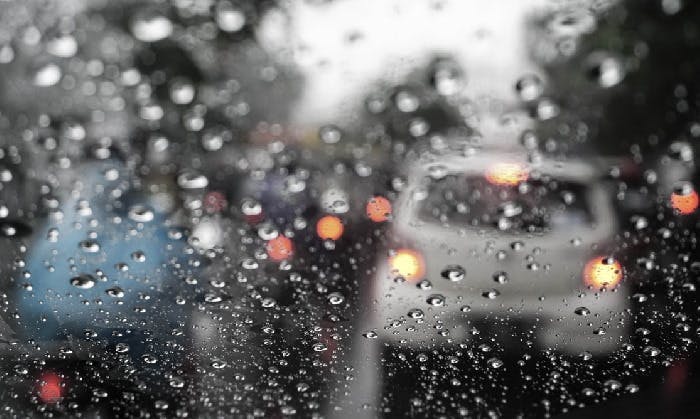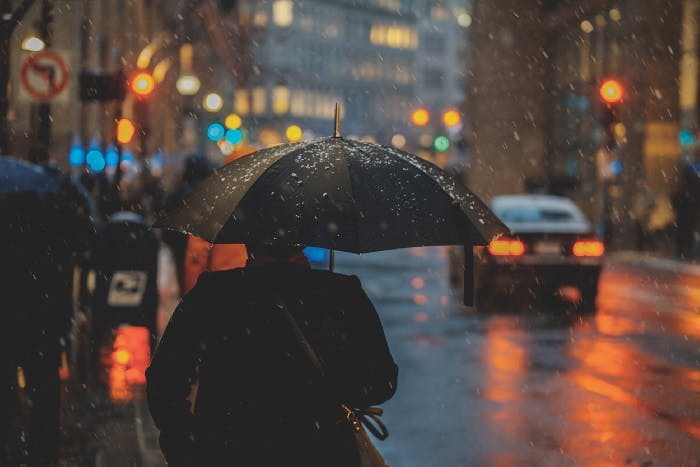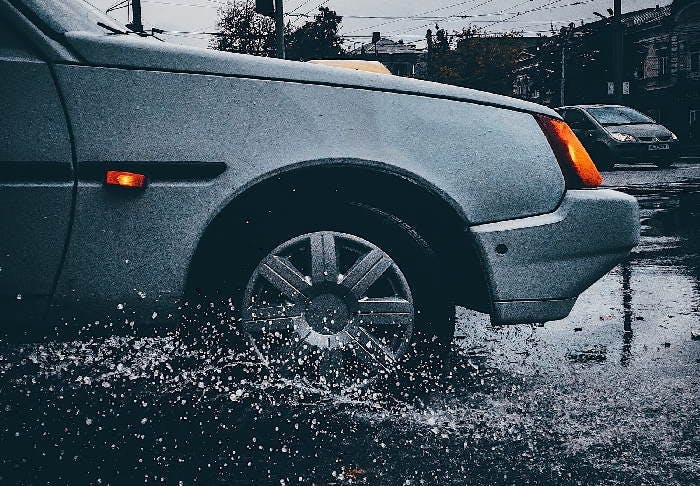
Let's face it: no matter the season, if you're driving in Britain, you need to be prepared for a little (or a lot) of rain. The odd light shower shouldn't have much of an impact on your driving. When it starts to really pour it down, however, you need to make certain adjustments to keep yourself and other road users safe.
To make this process easy-peasy, PassMeFast has created a list of our top tips for driving in the rain. Check it out below!
1. Easy does it!

If you're driving along and notice raindrops starting to fall from the sky, you should immediately rethink your speed and the distance you're maintaining from the vehicles up ahead. This is not to say you have to make these adjustments straight away—you just need to be prepared. If the raindrops turn into a full-on shower, switch to a more cautious style of driving.
Let's turn to the driving holy grail, the Highway Code, for some clarity on this. Section 227 states:
In wet weather, stopping distances will be at least double those required for stopping on dry roads (...) because your tyres have less grip on the road.
Reduce your speed slightly and leave bigger gaps between vehicles to account for this increased braking distance.
2. Now you see me...

The really annoying thing about rain is that it obscures your vision of the road. Depending on the type of shower, its effect on your visibility can range from mild to severe. No matter the type of rain, it's a good idea to get those windscreen wipers turned on. If it's just a light smattering of rain, you can probably stick to the lowest setting.
Keep in mind that during heavy flash floods, if you have the option, it could be safer to actually pull over, park up and wait for it to pass. Obviously, you should only attempt this if you have a safe opportunity to do so.
Top tip
You may also notice that the miserable weather causes your car windows to steam up on the inside, further obstructing visibility. Turn on your demisters nice and early to prevent this becoming a real hazard!
3. Shine a light
If the wet weather is really impacting visibility, you also need to consider the fact that other vehicles won't be able to see you as clearly either. At a certain point it may be necessary to turn on your lights, even if it's the middle of the day.
Stick to dipped headlights only. Full beam lights can dazzle other drivers, while fog lights make it difficult for other drivers to notice your brake lights.
4. Be mindful of others

If you consider the rain a pain from the comfort of your car, imagine how unwelcome it is for pedestrians and cyclists! They don't benefit from the same protection from the elements as you. If you drive by them too closely or at a high speed, you actually risk completely drenching them in water. As tempting as this may be if you're having a bad day, please resist. Not only is it extremely bad road etiquette, but it's also potentially dangerous.
In bad weather conditions it can be harder to spot other road users, so be extra vigilant when keeping an eye out for cyclists, motorcyclists and pedestrians. You should also bear in mind that people act differently in the rain. Pedestrians, for example, are much more likely to take risks, like rushing across the road, in an attempt to get out of the rain.
5. Avoid the deep end!

If driving in heavy rain (or just after) be prepared for the fact that certain parts of the road may be flooded. Following tip number 1 of controlling your speed should help you avoid an accident here.
From the surface, it is very hard to tell how deep a puddle actually is. This is a problem, because driving through pools of water can inflict significant damage on your vehicle's engine and electrical systems. Wherever possible, drive around large puddles when it is safe to do so.
Aquaplaning is also a significant risk when driving through puddles. This may sound cool, but it ain't. Far from being a favourite pastime of Jason Momoa, aquaplaning is when your tyres lose contact with the road, causing you to lose control of the steering. If this happens, the important thing to do is stay calm and resist the urge to speed up or brake. Instead, slowly ease off the accelerator until you regain control.
Top tip
If you do end up driving through a large puddle, be sure to test that your brakes are still in good working order soon after. You can do this by gently applying them as the car is in motion.
Rain may be a normal occurrence, but in the context of driving it can actually be a significant hazard. This is not something you need to be too worried about if you know what to do. The best way to be prepared is to make sure that you take some lessons in the rain while you're a learner. This should not be hard to achieve if you're in the UK!
Our top tips above will help you out when you get caught in the rain unexpectedly. If you're making a planned drive once bad weather has already started, however, there are a few extra steps you can take. Have a look at our journey checklist below!
Driving in the rain: Journey checklist
- Do your research before setting off by consulting the local traffic news for flood warnings or existing road issues.
- Fuel up! The extra functions you are required to use when it's raining (windscreen wipers, demisters, etc.) will burn energy, so make sure you have plenty of petrol.
- Check that your tyres are in good working order because grip is extra important in the rain!
- Test the windscreen wipers and top up the windscreen cleaning solution if necessary.
- Wipe your feet on the car mat before using the pedals to ensure that your shoes are not slippery.
- Ensure that all of your car's lights are in good working order.
- Consider whether your journey is really necessary—if the weather is really bad, it might not be worth the risk!
Subscribe for driving advice, offers & more
We'd love to let you know about our courses, news and offers via email. You may unsubscribe at any time.
Star Genie Limited trading as PassMeFast. Company number 10093359
Copyright © 2024 owned by Star Genie Limited
PassMeFast, Blue Tower, MediaCityUK, Salford, M50 2ST

